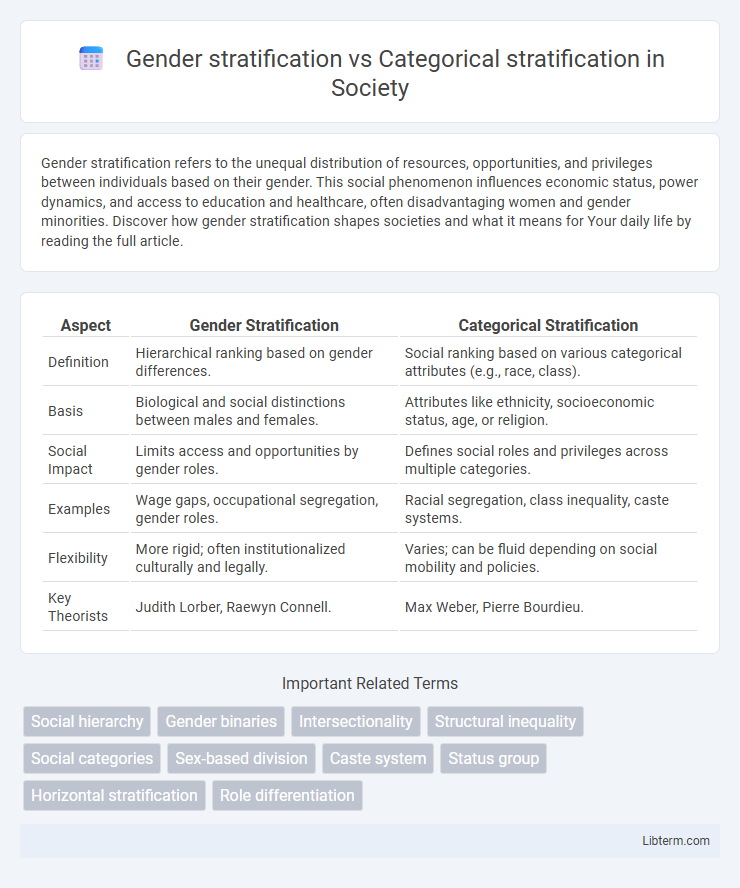Gender stratification refers to the unequal distribution of resources, opportunities, and privileges between individuals based on their gender. This social phenomenon influences economic status, power dynamics, and access to education and healthcare, often disadvantaging women and gender minorities. Discover how gender stratification shapes societies and what it means for Your daily life by reading the full article.
Table of Comparison
| Aspect | Gender Stratification | Categorical Stratification |
|---|---|---|
| Definition | Hierarchical ranking based on gender differences. | Social ranking based on various categorical attributes (e.g., race, class). |
| Basis | Biological and social distinctions between males and females. | Attributes like ethnicity, socioeconomic status, age, or religion. |
| Social Impact | Limits access and opportunities by gender roles. | Defines social roles and privileges across multiple categories. |
| Examples | Wage gaps, occupational segregation, gender roles. | Racial segregation, class inequality, caste systems. |
| Flexibility | More rigid; often institutionalized culturally and legally. | Varies; can be fluid depending on social mobility and policies. |
| Key Theorists | Judith Lorber, Raewyn Connell. | Max Weber, Pierre Bourdieu. |
Understanding Gender Stratification
Gender stratification refers to the unequal distribution of resources, power, and opportunities between men and women, deeply embedded in social institutions and cultural norms. Understanding gender stratification involves analyzing how societal expectations and roles perpetuate disparities in income, education, and political representation. Unlike categorical stratification, which classifies individuals based on various social categories like race, class, or age, gender stratification specifically highlights systemic inequalities tied to gender identity and roles.
Key Characteristics of Categorical Stratification
Categorical stratification organizes social groups based on inherent or assigned characteristics such as race, ethnicity, or gender, often leading to systemic inequalities. Key characteristics include rigid boundaries between categories, limited mobility across groups, and social hierarchies that assign differential access to resources and power. This form of stratification contrasts with gender stratification by emphasizing multiple categorical distinctions rather than focusing solely on gender-based roles and disparities.
Historical Evolution of Gender Stratification
Gender stratification has evolved historically through patriarchal systems that institutionalized male dominance in social, economic, and political spheres, deeply embedding unequal power relations based on gender roles. Unlike categorical stratification, which organizes individuals into diverse social categories like race or class, gender stratification specifically enforces binary divisions and hierarchical power structures between men and women, often justified by cultural and religious norms. The historical evolution of gender stratification reflects shifts from agrarian societies to industrial and post-industrial economies, where changes in labor demands and feminist movements have continuously challenged and reshaped gender hierarchies.
Social Impacts of Categorical Stratification
Categorical stratification creates fixed social divisions based on race, ethnicity, or class, leading to unequal access to resources, education, and employment opportunities. This form of stratification reinforces systemic discrimination, impacting social mobility and perpetuating poverty cycles within marginalized groups. The resulting social impacts include heightened social tensions, reduced social cohesion, and persistent economic disparities across different social categories.
Comparative Analysis: Gender vs Categorical Stratification
Gender stratification organizes social hierarchies based on gender roles, influencing access to resources and power predominantly along male-female lines, while categorical stratification divides society into groups based on multiple social categories such as race, class, or ethnicity, affecting life chances through intersecting identities. Gender stratification often produces systemic inequalities rooted in patriarchal systems, whereas categorical stratification incorporates a broader scope of social divisions that combine to generate complex patterns of privilege and disadvantage. Comparative analysis reveals that gender stratification is a specific form of categorical stratification, with gender intersecting other social categories to deepen stratified social outcomes.
Structural Foundations of Gender Inequality
Gender stratification refers to the unequal distribution of resources, opportunities, and privileges between genders based on societal norms and roles, deeply embedded in institutional practices and policies. Categorical stratification organizes individuals into hierarchical groups defined by characteristics such as race, class, or age, intersecting with gender to exacerbate systemic inequalities. Structural foundations of gender inequality are maintained through legal frameworks, labor market segmentation, and cultural ideologies that legitimize and perpetuate gender-based disparities within these stratification systems.
Mechanisms of Categorical Stratification
Categorical stratification operates through mechanisms such as social categorization, discrimination, and unequal access to resources based on group membership, reinforcing systemic inequalities. Unlike gender stratification, which specifically targets disparities related to gender roles and expectations, categorical stratification encompasses broader social divisions including race, ethnicity, class, and age. These mechanisms perpetuate power imbalances by institutionalizing social hierarchies and limiting opportunities for marginalized categories within society.
Intersectionality in Gender and Categorical Stratification
Gender stratification refers to the unequal distribution of resources, power, and opportunities based on gender, while categorical stratification involves hierarchical divisions across various social categories such as race, class, and age. Intersectionality highlights how multiple social identities, including gender, race, and class, overlap to create complex systems of oppression and privilege within both gender and categorical stratifications. Understanding intersectionality is crucial for analyzing how distinct social stratifications interact, shaping individuals' experiences and reinforcing systemic inequalities.
Policy Implications and Social Change Strategies
Gender stratification often leads to policies emphasizing equality in employment, education, and healthcare to address systemic disparities between men and women, whereas categorical stratification encompasses broader social divisions such as race, class, or ethnicity, requiring multifaceted policy approaches targeting multiple axes of inequality. Policy implications for gender stratification prioritize affirmative action, gender-sensitive legislation, and reproductive rights reforms, while strategies for categorical stratification involve intersectional frameworks to dismantle overlapping systems of oppression. Social change strategies include targeted advocacy, community empowerment programs, and institutional reforms designed to promote equity across all stratified categories, ensuring inclusive and sustainable progress.
Future Perspectives on Stratification Systems
Future perspectives on stratification systems indicate an increasing complexity as gender stratification intersects with categorical stratification, encompassing race, class, and ethnicity. Technological advancements and social movements are expected to reshape existing hierarchies, promoting more fluid and inclusive models of identity and social positioning. Data-driven policies and interdisciplinary research will play critical roles in addressing systemic inequalities embedded within these stratification systems.
Gender stratification Infographic

 libterm.com
libterm.com